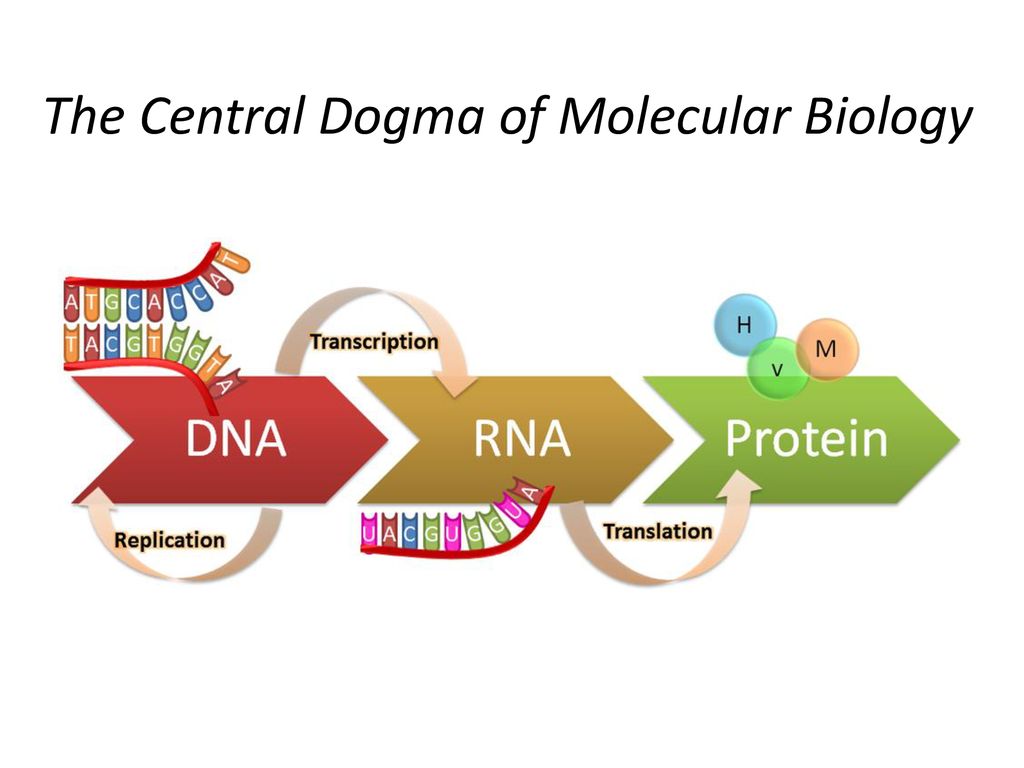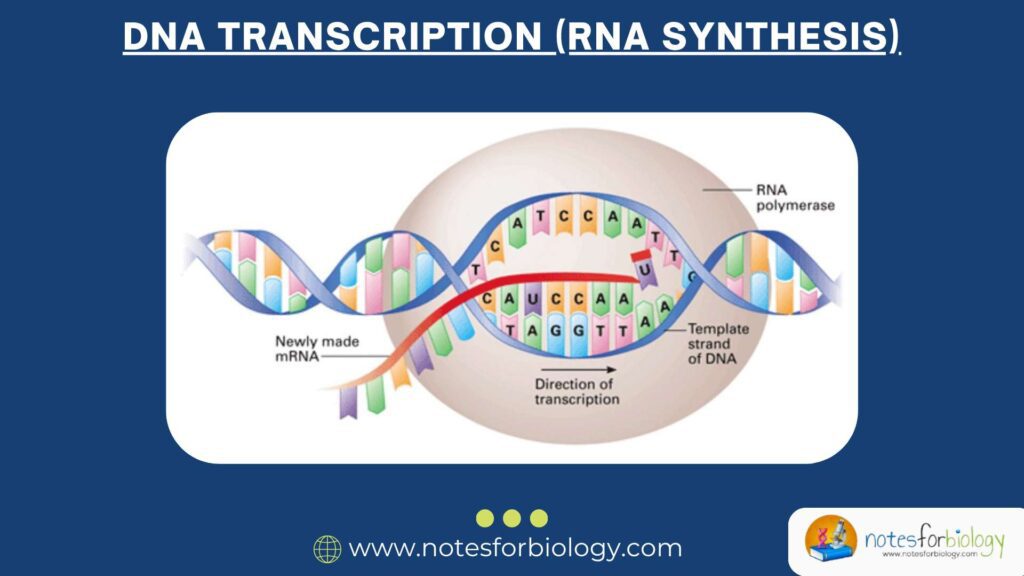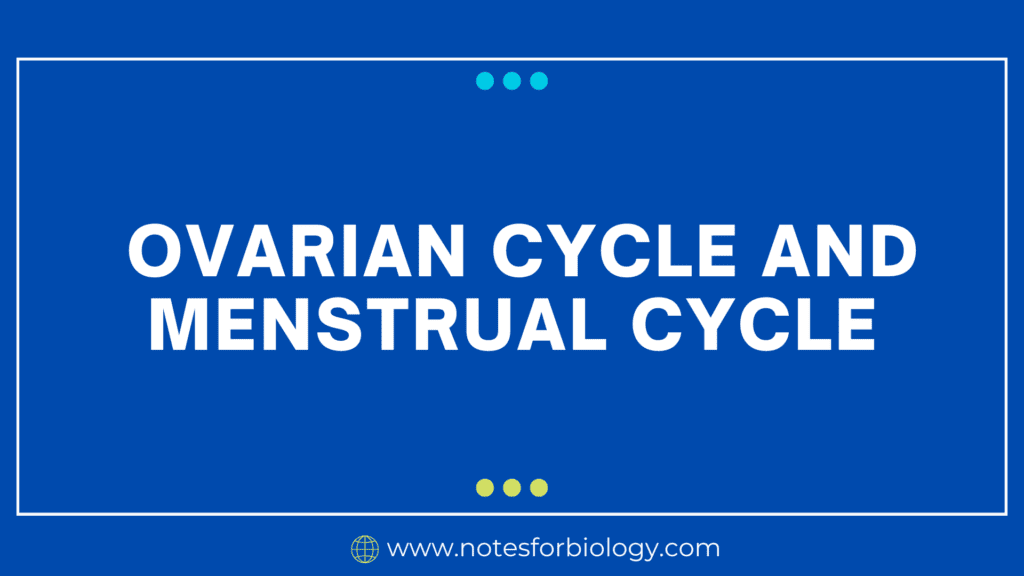Introduction
In every living cell, there is a process constantly happening that acts as a bridge between the stored genetic information in DNA and the proteins that carry out the work of life. This process is called transcription, and it is the first step in the central dogma of molecular biology—DNA → RNA → Protein.
Transcription is the process by which a segment of DNA is used to produce a complementary RNA molecule. This RNA can be a messenger RNA (mRNA), which later gets translated into protein, or it can be a non-coding RNA like tRNA or rRNA, which perform structural and functional roles within the cell. DNA transcription is absolutely essential for life because it turns the static code of DNA into dynamic molecules that perform specific functions.
In this detailed explanation, we’ll explore DNA transcription from its definition and principle to its enzymes, steps, types, regulation, and significance. Our goal is to make this topic clear and easy to understand using a humanized approach while covering every aspect thoroughly.
Table of Contents
What is DNA Transcription?
DNA transcription is the biological process through which a particular segment of DNA is copied into RNA by the enzyme RNA polymerase. During transcription, one strand of DNA (called the template strand) is used to generate a single-stranded RNA molecule. The newly made RNA strand is complementary to the DNA template and carries the genetic instructions needed for further cellular processes like protein synthesis.

If we compare DNA to a cookbook, transcription is like copying a specific recipe onto a sticky note so you can carry it into the kitchen (ribosome) without risking the original book (DNA).
The Central Dogma of Molecular Biology
To better understand transcription, it helps to know the central dogma, which explains the flow of genetic information:

- Replication: DNA is copied to make more DNA.
- Transcription: DNA is converted into RNA.
- Translation: RNA is used to make proteins.
Among these, transcription is the step that connects the genetic storage (DNA) with gene expression (RNA and proteins).
Importance of DNA Transcription
- Gene expression: Only the needed genes are transcribed, allowing cells to control which proteins are produced.
- Adaptability: Cells can respond to environmental changes by altering which genes they transcribe.
- Cell identity: Different patterns of transcription give rise to different cell types (muscle cells, neurons, etc.).
- Development: Transcription controls how organisms grow and differentiate from a single cell.
Principle of DNA Transcription
The basic principle of transcription involves base pairing between nucleotides, just like DNA replication, but instead of copying both strands, only one strand of DNA is used to make a complementary RNA strand.
The DNA strand that serves as the template is called the template strand or antisense strand. The other strand, which is not used, is the coding strand or sense strand because it has the same sequence as the RNA (except that T is replaced by U in RNA).
Base Pairing Rule in DNA Transcription:
- DNA A → RNA U
- DNA T → RNA A
- DNA G → RNA C
- DNA C → RNA G
Unlike replication, transcription doesn’t need a primer and produces a single-stranded product.
Enzymes and Molecules Involved In DNA Transcription
1. RNA Polymerase
The key enzyme in transcription. It reads the DNA template and synthesizes the RNA strand by adding ribonucleotides one by one.
- In prokaryotes, there is one type of RNA polymerase.
- In eukaryotes, there are three main types:
- RNA Polymerase I: Synthesizes rRNA
- RNA Polymerase II: Synthesizes mRNA
- RNA Polymerase III: Synthesizes tRNA and other small RNAs
2. Transcription Factors (in eukaryotes)
Proteins that help RNA polymerase recognize and bind to promoter regions on DNA.
3. Ribonucleotides
The building blocks of RNA: Adenine (A), Uracil (U), Cytosine (C), and Guanine (G).
4. Promoters and Terminators
Promoters are DNA sequences that signal the start of a gene. Terminators signal the end of transcription.
Steps of Transcription
DNA transcription occurs in three main stages: Initiation, Elongation, and Termination.

Step 1: Initiation
The transcription process begins when RNA polymerase binds to a specific sequence on the DNA called the promoter.
- In prokaryotes, the promoter often includes a -10 and -35 sequence upstream of the gene.
- In eukaryotes, the promoter includes a TATA box and other regulatory sequences.
Once the RNA polymerase binds, the DNA unwinds locally, exposing the template strand. This region is called the transcription bubble.
Step 2: Elongation
After binding and initiation, RNA polymerase starts adding ribonucleotides that are complementary to the DNA template.
- The RNA chain grows in the 5′ to 3′ direction.
- The DNA behind the polymerase rewinds while the DNA ahead continues to unwind.
- RNA polymerase moves along the DNA, synthesizing the RNA strand.
This step continues until the polymerase reaches a termination signal.
Step 3: Termination
This is the final step where the RNA polymerase stops transcription and releases the RNA transcript.
- In prokaryotes, termination can be rho-dependent or rho-independent:
- Rho-dependent: Involves a protein called rho that helps dislodge RNA polymerase.
- Rho-independent: Depends on hairpin loops in the RNA that destabilize the complex.
- In eukaryotes, termination involves specific DNA sequences and protein factors. For mRNA, termination occurs beyond the coding region, followed by cleavage and polyadenylation.
Post-Transcriptional Modifications (in Eukaryotes)
After transcription, the newly made pre-mRNA (primary transcript) undergoes several changes before it becomes a functional mRNA.
1. 5′ Capping
A modified guanine nucleotide is added to the 5′ end. This cap:
- Protects the RNA from degradation
- Helps in ribosome binding during translation
2. 3′ Polyadenylation
A string of adenine nucleotides (poly-A tail) is added to the 3′ end. This:
- Increases RNA stability
- Assists in nuclear export and translation
3. Splicing
Non-coding regions (introns) are removed, and coding regions (exons) are joined together.
- This process is done by a complex called the spliceosome.
- Allows alternative splicing, where different combinations of exons create different proteins from the same gene.
Types of RNA Produced During DNA Transcription
Different types of RNA are synthesized depending on the gene and the RNA polymerase used.
1. Messenger RNA (mRNA)
- Carries the genetic code from DNA to the ribosome for protein synthesis.
- Undergoes capping, splicing, and polyadenylation in eukaryotes.
2. Ribosomal RNA (rRNA)
- A structural and functional component of ribosomes.
- Synthesized by RNA polymerase I (eukaryotes).
3. Transfer RNA (tRNA)
- Brings amino acids to the ribosome during translation.
- Has a unique cloverleaf structure.
4. Small Nuclear RNA (snRNA)
Involved in RNA splicing.
5. Micro RNA (miRNA) and Small Interfering RNA (siRNA)
Involved in gene regulation by RNA interference.
Differences Between Prokaryotic and Eukaryotic Transcription
| Feature | Prokaryotic Transcription | Eukaryotic Transcription |
|---|---|---|
| Location | Cytoplasm | Nucleus |
| RNA Polymerase | One type | Three types |
| Promoter Elements | -10, -35 regions | TATA box, enhancers |
| RNA Processing | None (RNA is used directly) | Extensive processing (capping, splicing, polyadenylation) |
| Transcription and Translation | Happen simultaneously | Occur separately |
Regulation of Transcription
Gene expression is tightly controlled, and transcription is one of the most important control points.
In Prokaryotes
- Operons regulate transcription. For example:
- Lac operon: Turns on only when lactose is present and glucose is absent.
- Trp operon: Represses transcription when tryptophan is abundant.
- Regulatory proteins like repressors and activators bind to DNA to control RNA polymerase access.
In Eukaryotes
- Transcription factors help or block RNA polymerase binding.
- Enhancers and silencers are distant DNA elements that regulate transcription.
- Epigenetic modifications like DNA methylation and histone acetylation affect chromatin structure and gene expression.
Significance of Transcription in Biology and Medicine
1. Protein Synthesis
Transcription is the first step in making proteins that run all biological processes.
2. Development and Differentiation
Selective transcription allows stem cells to become specific cell types like neurons, skin, or muscle.
3. Response to Environment
Cells adjust gene expression in response to stress, hormones, or nutrients through transcriptional changes.
4. Disease Understanding
Abnormal transcription can cause diseases like cancer, autoimmune disorders, or genetic syndromes.
5. Therapeutics and Research
- RNA-based therapies target transcriptional pathways.
- Technologies like qPCR, RT-PCR, and RNA sequencing rely on transcription analysis.
Experimental Techniques to Study Transcription
1. RT-PCR (Reverse Transcription PCR)
Used to measure the amount of mRNA in a sample.
2. Northern Blot
Detects specific RNA molecules.
3. Microarrays
Study expression levels of thousands of genes at once.
4. RNA-Seq
High-throughput sequencing of all RNA in a sample.
5. ChIP (Chromatin Immunoprecipitation)
Used to study transcription factor binding sites.
Disorders Related to Transcription Errors
- Cancer: Unregulated gene transcription can lead to oncogene activation or tumor suppressor silencing.
- Neurodegenerative diseases: Aberrant transcription of key genes in neurons.
- Thalassemia: Caused by mutations affecting transcription of globin genes.
Conclusion
DNA transcription is a beautifully orchestrated process that allows our cells to bring the genetic code to life. It’s not just about copying DNA into RNA—it’s about controlling gene activity, shaping development, responding to change, and maintaining health.
Understanding transcription gives us powerful insight into how genes function, how diseases arise, and how we can harness biology for treatments and technology. From the single-celled bacteria to the complex human brain, transcription drives the symphony of life.
Three Key Summary
- DNA transcription is the process of copying genetic information from DNA into RNA using RNA polymerase.
- It involves three main stages: initiation, elongation, and termination, followed by RNA processing in eukaryotes.
- Transcription is vital for gene expression, cell specialization, and biological regulation, with wide applications in health, research, and biotechnology.
FREQUENTLY ASKED QUESTIONS
What is the main enzyme involved in transcription?
RNA polymerase is the main enzyme that synthesizes RNA from the DNA template.
What happens to the RNA after transcription?
In eukaryotes, RNA undergoes processing—capping, splicing, and polyadenylation—before it is translated into protein.
What is the difference between transcription and replication?
Replication copies the entire DNA to make more DNA. Transcription copies only specific genes to make RNA
Related Articles




